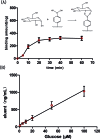A novel probe based on phenylboronic acid functionalized carbon nanotubes for ultrasensitive carbohydrate determination in biofluids and semi-solid biotissues
- PMID: 29910906
- PMCID: PMC5975936
- DOI: 10.1039/c5sc03992d
A novel probe based on phenylboronic acid functionalized carbon nanotubes for ultrasensitive carbohydrate determination in biofluids and semi-solid biotissues
Abstract
Carbohydrates are known to be involved in a wide range of biological and pathological processes. However, due to the presence of multiple hydroxyl groups, carbohydrate recognition is a particular challenge. Herein, we reported an ultrasensitive solid-phase microextraction (SPME) probe based on phenylboronic acid (PBA) functionalized carbon nanotubes (CNTs) for direct in vitro or in vivo recognition of carbohydrates in biofluids as well as semi-solid biotissues. The coating of the proposed probe possessed a 3D interconnected porous architecture formed by the stacking of CNTs. As a result, the binding capacity toward carbohydrates was excellent. The proposed approach was demonstrated to be much superior to most carbohydrate sensors, including higher sensitivity, wider linear range, and excellent qualitative ability in multi-carbohydrate systems. Thus, this approach opens up new avenues for the facile and efficient recognition of carbohydrates for important applications such as glycomics.
Figures







Similar articles
-
Carbon nanotubes reinforced hollow fiber solid phase microextraction for the determination of strychnine and brucine in urine.Talanta. 2013 Nov 15;116:188-94. doi: 10.1016/j.talanta.2013.05.025. Epub 2013 May 16. Talanta. 2013. PMID: 24148391
-
Aptamer-functionalized solid phase microextraction-liquid chromatography/tandem mass spectrometry for selective enrichment and determination of thrombin.Anal Chim Acta. 2014 Oct 3;845:45-52. doi: 10.1016/j.aca.2014.08.018. Epub 2014 Aug 13. Anal Chim Acta. 2014. PMID: 25201271
-
In vivo investigation of pesticide residues in garlic using solid phase microextraction-gas chromatography-mass spectrometry.Anal Chim Acta. 2019 Dec 20;1090:72-81. doi: 10.1016/j.aca.2019.09.011. Epub 2019 Sep 6. Anal Chim Acta. 2019. PMID: 31655648
-
Carbohydrate functionalized carbon nanotubes and their applications.Chem Soc Rev. 2010 Aug;39(8):2925-34. doi: 10.1039/b919525b. Epub 2010 Jun 28. Chem Soc Rev. 2010. PMID: 20585681 Review.
-
Carbon-based sorbents: carbon nanotubes.J Chromatogr A. 2014 Aug 29;1357:53-67. doi: 10.1016/j.chroma.2014.04.039. Epub 2014 Apr 18. J Chromatogr A. 2014. PMID: 24792692 Review.
Cited by
-
Carbon and Tin-Based Polyacrylonitrile Hybrid Architecture Solid Phase Microextraction Fiber for the Detection and Quantification of Antibiotic Compounds in Aqueous Environmental Systems.Molecules. 2019 Apr 28;24(9):1670. doi: 10.3390/molecules24091670. Molecules. 2019. PMID: 31035407 Free PMC article.
-
A molecularly imprinted electrochemical biosensor based on hierarchical Ti2Nb10O29 (TNO) for glucose detection.Mikrochim Acta. 2021 Dec 11;189(1):24. doi: 10.1007/s00604-021-05128-x. Mikrochim Acta. 2021. PMID: 34894290
-
Hydroxyl-triggered fluorescence for location of inorganic materials in polymer-matrix composites.Chem Sci. 2017 Oct 16;9(1):218-222. doi: 10.1039/c7sc03897f. eCollection 2018 Jan 7. Chem Sci. 2017. PMID: 29629090 Free PMC article.
-
Recent development of boronic acid-based fluorescent sensors.RSC Adv. 2018 Aug 20;8(51):29400-29427. doi: 10.1039/c8ra04503h. eCollection 2018 Aug 14. RSC Adv. 2018. PMID: 35548017 Free PMC article. Review.
-
Nanotechnology in Glycomics: Applications in Diagnostics, Therapy, Imaging, and Separation Processes.Med Res Rev. 2017 May;37(3):514-626. doi: 10.1002/med.21420. Epub 2016 Nov 15. Med Res Rev. 2017. PMID: 27859448 Free PMC article. Review.
References
-
- Timmer M. S., Stocker B. L., Seeberger P. H. Curr. Opin. Chem. Biol. 2007;11:59–65. - PubMed
-
- Davidson M. B. Diabetes Care. 1998;21:2152–2160. - PubMed
-
- Walt D., Aoki-Kinoshita K. F., Bendiak B., Bertozzi C., Boons G., Darvill A., Hart G., Kiessling L., Lowe J. and Moon R., Transforming glycoscience: a roadmap for the future, National Academies Press, Washington, DC, 2012. - PubMed
-
- Davis A. P., Wareham R. S. Angew. Chem., Int. Ed. 1999;38:2978–2996. - PubMed
-
- Kubik S. Angew. Chem., Int. Ed. 2009;48:1722–1725. - PubMed
LinkOut - more resources
Full Text Sources
Other Literature Sources
Research Materials

